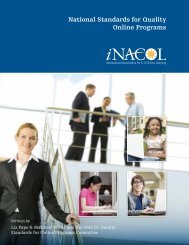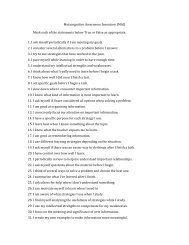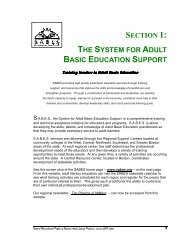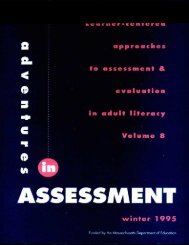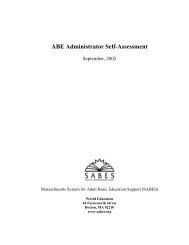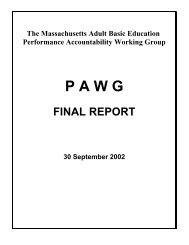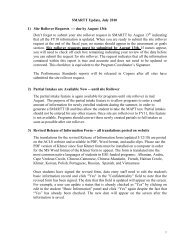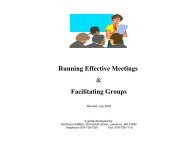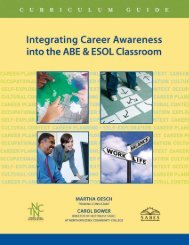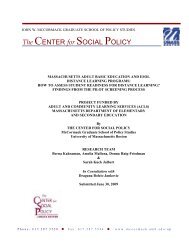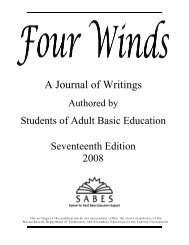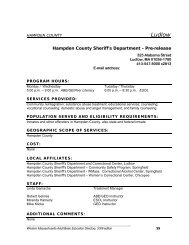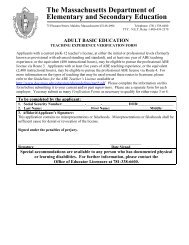Introduction to the ABE Curriculum Frameworks - SABES
Introduction to the ABE Curriculum Frameworks - SABES
Introduction to the ABE Curriculum Frameworks - SABES
Create successful ePaper yourself
Turn your PDF publications into a flip-book with our unique Google optimized e-Paper software.
The Massachusetts <strong>ABE</strong><br />
<strong>Curriculum</strong> <strong>Frameworks</strong><br />
AN OVERVIEW<br />
Developed by <strong>the</strong> S<strong>ABE</strong>S<br />
<strong>Curriculum</strong> & Assessment Team
The Massachusetts<br />
<strong>ABE</strong> <strong>Curriculum</strong> <strong>Frameworks</strong> are:<br />
A collection of teaching philosophies<br />
and practices that Massachusetts adult<br />
educa<strong>to</strong>rs have identified as important<br />
A compilation of skills and knowledge<br />
that adult educa<strong>to</strong>rs have identified as<br />
important for ESOL and <strong>ABE</strong> students<br />
<strong>to</strong> acquire<br />
Not “curriculum” but guides for<br />
curriculum development
The Six <strong>Curriculum</strong> <strong>Frameworks</strong>:<br />
Basic Skills Focused:<br />
• English Language Arts (ELA)<br />
• English for Speakers of O<strong>the</strong>r Languages<br />
(ESOL)<br />
• Ma<strong>the</strong>matics and Numeracy<br />
Content Focused:<br />
• His<strong>to</strong>ry & <strong>the</strong> Social Sciences<br />
• Science & Technology/Engineering<br />
• Health<br />
3
The Common Chapters<br />
A brief prelude that contains:<br />
“Habits of Mind” for effective learning—<br />
e.g., patience<br />
“Guiding Principles” for a conducive<br />
environment—e.g., Students/staff should<br />
have high expectations.<br />
Suggestions for how <strong>to</strong> use <strong>the</strong> <strong>Frameworks</strong><br />
Useful resources for developing curriculum<br />
4
Each Framework includes:<br />
Core Concepts<br />
Guiding Principles*<br />
Habits of Mind*<br />
Strands<br />
Standards<br />
Benchmarks (not in all <strong>Frameworks</strong>)<br />
*similar <strong>to</strong>, but more specific than, those in <strong>the</strong><br />
Common Chapters<br />
5
Core Concepts<br />
An articulation of <strong>the</strong> importance of a particular<br />
Framework area <strong>to</strong> <strong>the</strong> lives of adult learners.<br />
E.g., you’ll find this on page 12 of <strong>the</strong> Math CF:<br />
“Adults develop " numeracy skills and ma<strong>the</strong>matical<br />
fluency through actions involving<br />
problem solving, reasoning, decision making,<br />
communicating, and connecting in curriculum<br />
that links <strong>to</strong> <strong>the</strong>ir own ma<strong>the</strong>matics knowledge,<br />
experience, strategies, and goals.”<br />
6
Guiding Principles<br />
The underlying tenets that support effective<br />
learning, teaching, and assessment for a<br />
particular Framework area.<br />
You’ll find this on page 8 of <strong>the</strong> English Language<br />
Arts CF:<br />
"<br />
“Students practice all of <strong>the</strong> skills of <strong>the</strong><br />
language arts curriculum in <strong>the</strong> classroom,<br />
with varied materials, in multiple formats.”<br />
7
Habits of Mind<br />
Reasoned, purposeful, & transferable thinking<br />
patterns that are developed by study of <strong>the</strong><br />
particular Framework area.<br />
E.g., you’ll find <strong>the</strong>se explained in detail on Pages<br />
10-11 in <strong>the</strong> " Science & Tech/Engineering CF:<br />
Curiosity<br />
Open-Mindedness<br />
Creativity<br />
Wonderment<br />
Confidence<br />
8
Content Strands<br />
Organized categories of what adult learners need<br />
<strong>to</strong> know and be able <strong>to</strong> do within a certain<br />
Framework area.<br />
E.g., <strong>the</strong>se are <strong>the</strong> Strands of <strong>the</strong> ESOL CF:<br />
• Listening<br />
"<br />
• Speaking<br />
• Reading<br />
• Writing<br />
• Navigating Systems<br />
• Developing Strategies/Resources for<br />
Learning<br />
• Intercultural Knowledge & Skills<br />
9
Learning Standards<br />
The knowledge and skills within each strand <strong>to</strong> be<br />
mastered by adult learners.<br />
E.g., here are <strong>the</strong> three Standards within <strong>the</strong> Writing<br />
Strand of <strong>the</strong> English Language Arts CF:<br />
1. Learners will express <strong>the</strong>mselves through<br />
"<br />
writing for a variety of purposes.<br />
2. Learners will apply knowledge of English<br />
vocabulary, language structure, and mechanics<br />
when <strong>the</strong>y write.<br />
3. Learners will use a variety of strategies <strong>to</strong><br />
convey meaning through written English.<br />
10
Proficiency Levels & Benchmarks<br />
Some CFs also provide Proficiency<br />
Levels, which describe what students<br />
at a certain level know and can do in<br />
relation <strong>to</strong> what is being measured.<br />
And some CFs also provide<br />
Benchmarks, which describe <strong>the</strong><br />
specific set of skills learners need <strong>to</strong><br />
develop <strong>to</strong> meet a particular standard.<br />
11
Proficiency Levels & Benchmarks<br />
E.g., you’ll find <strong>the</strong>se in <strong>the</strong> chart on Page 33 of ESOL CF:<br />
Standard 1 (<strong>to</strong>p of page): “English language<br />
learners will comprehend spoken English from a<br />
variety of sources for various purposes.”<br />
Proficiency Level (<strong>to</strong>p left box): “Beginning<br />
Literacy, SPL 0-1”<br />
Benchmark L1.1a (directly below): “Follow nonverbal<br />
clues (e.g. pause, quizzical expression)<br />
and rising in<strong>to</strong>nation <strong>to</strong> determine when a<br />
response is expected”<br />
12
BASIC COMPONENTS<br />
Aligns <strong>the</strong> class<br />
levels <strong>to</strong><br />
ensure clear<br />
transitions<br />
from one class<br />
<strong>to</strong> ano<strong>the</strong>r.<br />
To <strong>the</strong> extent<br />
possible,<br />
curriculum<br />
components are<br />
based on<br />
research (cite<br />
resources) and<br />
verified by<br />
A practitioners.<br />
resource list<br />
describing proven<br />
applications, with<br />
brief annotations<br />
on relevance/<br />
usefulness.<br />
Connections <strong>to</strong><br />
technology (e.g.,<br />
a sample lesson<br />
plan for an<br />
integrated<br />
technology<br />
lesson).<br />
Aligns with <strong>the</strong><br />
Massachusetts <strong>ABE</strong><br />
<strong>Curriculum</strong> <strong>Frameworks</strong>,<br />
students’ assessment levels,<br />
students’ goals, and reflects<br />
<strong>the</strong> individual program’s<br />
mission.<br />
Current and<br />
archived<br />
lesson<br />
plans from<br />
<strong>the</strong><br />
different<br />
class<br />
levels.<br />
<strong>Curriculum</strong> is a longterm,<br />
written plan<br />
that guides <strong>the</strong><br />
content and skills<br />
specific for each class<br />
in a program.<br />
<strong>Curriculum</strong><br />
(<strong>the</strong>matic)<br />
units that<br />
align with<br />
student<br />
goals and<br />
interests.<br />
Includes<br />
recommended<br />
texts and o<strong>the</strong>r<br />
proven resources<br />
that are used in<br />
<strong>the</strong> program.<br />
How varied<br />
classroom<br />
assessments<br />
are used<br />
<strong>to</strong> determine<br />
progress from<br />
level <strong>to</strong> level.<br />
BEYOND THE BASICS<br />
Is presented in a<br />
format that is<br />
accessible <strong>to</strong> all<br />
practitioners in <strong>the</strong><br />
program.<br />
The program’s teaching<br />
philosophy.<br />
The methodologies and<br />
strategies that teachers<br />
as a group<br />
support (e.g., <strong>the</strong> <strong>ABE</strong><br />
<strong>Frameworks</strong>’ Guiding<br />
Principles, Habits of<br />
Mind, <strong>the</strong>me or projectbased<br />
learning,<br />
managing multiple<br />
levels, regular use of<br />
au<strong>the</strong>ntic materials,<br />
Multiple<br />
A<br />
Intelligences).<br />
scope and<br />
sequence for class<br />
levels (e.g., how <strong>the</strong><br />
content and skills are<br />
introduced <strong>to</strong> students<br />
in a logical, sequential,<br />
and meaningful<br />
manner). 13
Key Resources<br />
<br />
<br />
<br />
<br />
S<strong>ABE</strong>S <strong>Curriculum</strong> & Assessment<br />
Coordina<strong>to</strong>rs (CACs)<br />
S<strong>ABE</strong>S Library—and our Librarian.<br />
S<strong>ABE</strong>S & ACLS Websites<br />
• www.sabes.org<br />
• www.doe.mass.edu<br />
Assessment Policy Manuals<br />
<strong>Curriculum</strong> <strong>Frameworks</strong><br />
Professional development activities<br />
14



